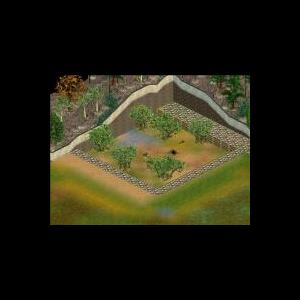About This File
Aardvark By LAwebTek
The aardvark is an odd-looking beast, resembling a giant, hump-backed rat with the head of an anteater, the snout of a pig, and the ears of a rabbit. It grows up to seven-and-a-half feet (2.3 meters) long, including its rat-like though thick and powerful tail. Adults average 110-150 pounds (50-70 kg), but may weigh as much as 180 pounds (82 kg).
Scientists placed the aardvark in its own order, Tubulidentata, which means tubule toothed. The name derives from the aardvark’s cheek teeth, which resemble flat-crowned columns. Each tooth is made of numerous tubular pulp cavities surrounded by hexagonal prisms of dentine.
Aardvarks are covered with thick pinkish-gray skin that protects them from insect bites and may even save them from predators. It is scantily covered with bristly hair varying from dull brownish-gray to dull yellowish-gray. Hair on the legs is often darker than that on the body. Low forequarters add to aardvark’s hump-backed appearance. Short, stocky legs end in toes bearing long, straight, strong, and blunt claws. There are four toes on each front foot, five on each hind foot. The toes are webbed at the base.
When pursued by enemies, aardvarks have three choices. The first two are run or dig! The aardvark isn’t known as a fast runner, though it is said to escape with surprising speed. However, aardvarks excel at burrowing. An aardvark digging in soft earth can beat several people armed with shovels! Its powerful forefeet can even tear through hard, sun-baked ground. What about that third choice? If cornered, an aardvark fights back. It may strike with its tail or shoulders or rear on its hind legs and slash with its clawed forefeet. A desperate aardvark may even roll on its back, slashing with all four feet.
Like most animals, aardvarks prefer to simply avoid predators. They have acute hearing, and flee for their burrows at the least hint of danger. But their eyesight seems to be poor; they frequently crash into trees, bushes, and other obstructions when running.
Aardvarks aren’t commonly seen because they’re mostly nocturnal. They usually spend the day in their burrows, curled up in a tight circle, the hind limbs and tail protecting the snout. Sometimes, an aardvark may be seen sunning itself at its burrow entrance in the early morning.
The aardvark is today restricted to Africa. It ranges from southernmost Africa (the Cape of Good Hope) to southern Egypt, but is generally widespread in suitable habitat south of the Sahara Desert. Aardvarks make homes by excavating burrows that are about ten feet (3 meters) long. An aardvark tunnel ends in a chamber large enough for the animal to turn in. (Aardvarks generally enter and exit headfirst.)
Aardvarks that burrow in areas prone to seasonal flooding are sometimes forced to evacuate their burrows. Aardvarks reportedly occupy termite nest as temporary shelters (perhaps when they’ve been flooded out of their burrows!).
Numerous aardvarks may burrow in same vicinity. Their abandoned burrows provide homes for many other animals, including large and small mammal predators, porcupines, some birds, and even crocodiles and pythons. In fact, the aardwolf (which is not related to the aardvark) usually lives in aardvark burrows.
It is its diet that caused the aardvark to evolve a form and habits similar to anteaters and other ant and termite-eating mammals. An aardvark’s powerful claws are adapted to breaking open hard clay termite nests. Its narrow head can be thrust into holes and crevices and it laps up insects with a sticky tongue that can be extended as much as twelve inches (300 mm).
Updated 2010-10-30
Just to save space with less in zip and smaller image.
Nothing new.



Recommended Comments
There are no comments to display.
Create an account or sign in to comment
You need to be a member in order to leave a comment
Create an account
Sign up for a new account in our community. It's easy!
Register a new accountSign in
Already have an account? Sign in here.
Sign In Now